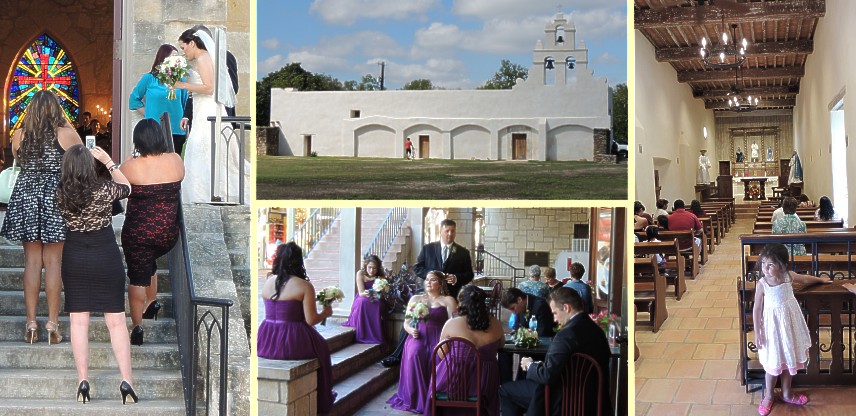Special message for my readers from hubby Art
Kansas Snapshots by Gloria Freeland - October 17, 2014
Different, yet alike
After an hour or so of wandering from shop to shop in the La Villita area of downtown San Antonio, Texas, it was
nice to sit and have a bite to eat outside a small café. We had heard that the little village's church was a popular
wedding site and so were not surprised when a group of bridesmaids and groomsmen joined us at a nearby table. A few
minutes later, the bride and groom arrived.
It seemed so typical of many weddings I had seen. The bride was all business as she completed last-minute tasks,
while the groom sat nervously next to her. The others in the bridal party chatted about this and that.
One thing that was different was that many in the bridal party appeared to be Hispanic, including the bride and
groom. But it wasn't surprising as this seventh-largest U.S. city is 63 percent Latino and only 25 percent white.
Census figures indicate that nearly half of its citizens speak a language other than English at home, and I'm guessing
that for most, that language is Spanish. This is nearly twice the national rate. Yet the percentage of foreign births
and the number of people under the age of 18 is near the national average. So it is not a city of immigrants with
large families.
A little research revealed how this came to be. While the Native Americans in my home state of Kansas encountered
an occasional French trader in the early part of the 18th century, San Antonio already had five Spanish missions in
operation. They, and 31 other settlements, were sprinkled along the El Camino Real de los Tejas - the royal road of
Texas. That was a pretty dignified name for what in 1680 was little more than a collection of paths made by Native
Americans.
It began in Guerrero, a mission in the present-day Mexican state of Coahuila. Crossing the Rio Grande, it traveled
northeast for about 600 miles, ultimately terminating at present-day Natchitoches, Louisiana.
There were two reasons for the settlements. The Catholic church wanted to see the indigenous Native Americans
converted to Christianity, while the Spanish crown saw them as a buffer zone between its silver-rich colonies in Mexico
and the French and British claims to the north and east. The Spanish governor in Mexico City provided supplies to
Guerrero. From there, they were transported along the El Camino Real to the various missions. Spain also encouraged
settlers to emigrate from its various territories.
These remote outposts were not very safe, but the threat came mainly from ruffians and nomadic Native Americans
hoping to pick up some easy food or weapons. So while the missions were built in the form of miniature walled cities,
the two or three soldiers stationed at each usually provided adequate security.
A good source of water was always a concern, so missions were located near rivers. Irrigation ditches watered
nearby farm lands and a well inside the mission walls provided water for its inhabitants.
Spain's hold on the area became a bit less firm when what became the Louisiana Purchase, including Natchitoches,
was transferred from Spanish to French ownership.
But France was more concerned with its own internal struggles and rival Britain than with what was happening in
North America. In 1803, these problems led to the selling to the United States the land that stretched from the Dakotas
through Louisiana and Colorado to the Mississippi River.
In 1821, Europe's problems allowed New Spain to shed its colonial status to become Mexico. But the increasing
number of citizens from the United States settling in Texas meant that Mexican control of the lands along the El
Camino Real was tenuous at best.
Then the central government in Mexico instituted laws that were unpopular in many of its outlying territories,
including those of what would become southern Texas. With support of Mexico by the local population waning, in April
1836, Sam Houston's army of Texans was able to send the Mexican army home for good. The southern counties, heavily
populated by Hispanics, became a part of the Republic of Texas - and now the state of Texas.
On our last day, we were able to visit three of the city's five missions, purposely avoiding the Alamo whose story
has become dominated by the fight for independence. We spent the most time at Mission San Juan Capistrano. Known for
its fertile farmlands, crops had included corn, beans, chilies, melons, cotton, sugar cane and squash. Plans are
moving forward to showcase the farming methods of the past, including employing the acequias - the original irrigation
canals.
It was nice to see it was not some forgotten remnant of the past. As we walked the grounds, singing came from the
church. When the pealing church bells signaled the end of mass, Art and I left the visitor center and made our way to
the cool church. But it was clear that another mass was about to begin as people began streaming inside. I was touched
by their obvious devotion and joyful demeanor.
I wanted to stay longer, but we had a plane to catch. Later, as our plane took off, I thought of how different the
stories of many of San Antonio's ancestors were from mine.
Then I remembered the wedding party we had seen the evening before. As the time for the ceremony drew near, the
party arose and began walking toward the church. The groom reached out with a single finger and touched the bride's
shoulder. She didn't seem to notice, intent on gathering her dress so she could walk. But he looked completely smitten,
and that touch seemed to be his attempt to make sure it was all real. So while our stories are different, somehow, in
the truly important things, we are much alike.
